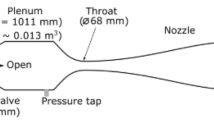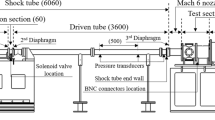Abstract
Magnetohydrodynamic (MHD) aerobraking has the potential to significantly reduce peak heat loads for high-speed planetary entry, due to increases in total drag force in the early phase of the trajectory. Establishing accurate techniques for measuring MHD drag force in ground testing facilities is a necessary first step for investigating this phenomenon. The objective of this paper is to demonstrate the methodology required for using a stress wave force balance (SWFB) to measure MHD drag force in an expansion tunnel. Whilst the SWFB is an established technique for measurement of short duration forces in impulse wind tunnel facilities, conventional designs exhibit unusually low signal-to-noise ratios in MHD ground testing flow fields, due to electromagnetic interference from the plasma in the shock layer. This paper investigates the effect that sting design, amplifier setup, and strain gauge location have on the signal-to-noise ratio of a SWFB. Experimental validation of each design was undertaken in the X2 expansion tunnel with a high enthalpy (\(\sim 16\,\hbox {MJ}\,\hbox {kg}^{-1}\)) argon test flow by comparing the results to those obtained using an accelerometer-based force balance. The results demonstrate that maximum signal-to-noise ratio is obtained when: the sting is made from a low stiffness material such as polycarbonate to maximise strain; the charge amplifier is located near the strain gauge inside the model and is grounded at the data acquisition system to minimise electrical noise; the strain gauge is located close to the applied load to delay the return of reflected stress waves from the free end. MHD drag forces measured in this study varied up to approximately 3 N, and measurement uncertainty was found to be approximately \(\pm \, 0.2\,\hbox {N}\). Overall, successful adaptation of the stress wave force balance technique to MHD ground testing was achieved, and it has been shown to be a viable alternative to accelerometer-based techniques.
Graphic abstract

















Similar content being viewed by others
References
Bush WB (1958) Magnetohydrodynamic-hypersonic flow past a blunt body. J Aerosp Sci 25(11):685–690
Levy RH, Gierasch PJ, Henderson DB (1964) Hypersonic magnetohydrodynamics with or without a blunt body. AIAA J 2(12):2091–2099
Smith MC, Wu CS (1964) Magnetohydrodynamic hypersonic viscous flow past a blunt body. AIAA J 2(5):963–965
Porter RW (1966) Theoretical aspects of blunt body magnetoaerodynamics. PhD thesis, Northwestern University
Fujino T, Shimosawa Y (2016) Numerical study of magnetohydrodynamic flow control along superorbital trajectories. J Spacecr Rockets 53(3):528–537
Smith DR, Gildfind DE, McIntye TJ, Mee DJ, James CM, Andrianatos A (2019) Magnetohydrodynamic drag force measurements in expansion tunnels using an accelerometer-based force balance. Exp Fluids 60:183
Gildfind DE, Smith DR, Lewis SW, Kelly R, James CM, Wei H, McIntyre TJ (2018) Expansion tube magnetohydrodynamic experiments with argon test gas. In: 2018 AIAA aviation and aeronautics forum and exposition
Gildfind DE, Smith DR, Thompson O, Jacobs PA (2019) Evaluation of electrically insulating coatings for magnetohydrodynamic aerobraking experimentation. In: 32 international symposium on shock waves
Seemann GR, Cambel AB (1966) Observations concerning magnetoaerodynamic drag and shock standoff distance. Proc Natl Acad Sci USA 55(3):457
Kawamura M, Matsuda A, Katsurayama K, Otsu H, Konigorski D, Sato S, Abe T (2009) Experiment on drag enhancement for a blunt body with electrodynamic heat shield. J Spacecr Rockets 46(6):1171–1177
Kawamura M, Nagata Y, Katsurayama H, Otsu H, Yamada K, Abe T (2013) Magnetoaerodynamic force on a magnetized body in a partially ionized flow. J Spacecr Rockets 50(2):347–351
Bityurin VA, Bocharov AN (2010) Ground mhd experiments in hypersonic flows. High Temp 48(6):874–880
Laurence SJ, Hornung HG (2009) Image-based force and moment measurement in hypersonic facilities. Exp Fluids 46(2):343–353
Sahoo N, Mahapatra DR, Jagadeesh G, Gopalakrishnan S, Reddy KP (2003) An accelerometer balance system for measurement of aerodynamic force coefficients over blunt bodies in a hypersonic shock tunnel. Meas Sci Technol 14(3):260–272
Sanderson SR, Simmons JM (1991) Drag balance for hypervelocity impulse facilities. AIAA J 29(12):2185–2191
Palmer RA (1999) Measurement of Heat Transfer in Superorbital Flows. PhD thesis, School of Mechanical and Mining Engineering, The University of Queensland
James CM, Birch BJC, Smith DR, Cullen TG, Millard T, Vella S, Liu Y, Morgan RG, Stern N, Buttsworth D (2019) Testing of ultra fast response, durable co-axial thermocouples for high enthalpy impulse facilities. In: 2019 AIAA aviation and aeronautics forum and exposition, Dallas, TX, USA
Chiu S (2004) Using an Expansion Tunnel to Generate Rarefied Hypervelocity Gas Flows. PhD thesis, School of Mechanical and Mining Engineering, The University of Queensland
Chiu HHS, Mee DJ (2003) Modified bar gauges. Technical report research report number 2003/22, The University of Queensland
Smith DR, Gildfind DE, McIntyre TJ, Mee DJ (2019) Stress wave force balance sting design for magnetohydrodynamic drag force measurements in expansion tubes. In: Asia Pacific international symposium on aerospace technology (APISAT 2019)
Mark Foster, Bryan Love, Robert Kaste, Paul Moy (2015) The rate dependent tensile response of polycarbonate and poly-methylmethacrylate. J Dyna Behav Mater 1:162–175
Smith AL, Mee DJ (1996) Dynamic strain measurement using piezoelectric polymer film. J Strain Anal Eng Des 31(6):463–465
Doherty LJ (2013) An experimental investigation of an airframe integrated three-dimensional scramjet engine at a mach 10 flight condition. PhD thesis, School of Mechanical and Mining Engineering—University of Queensland
Mee DJ (2003) Dynamic calibration of force balances for impulse hypersonic facilities. Shock Waves 12(6):443–455
Robinson MJ (2003) Calibration techniques, results and supporting documentation for the t4 component force balance. Technical report, The University of Queensland
Gildfind DE, Morgan RG, Jacobs PA (2016) Experimental methods of shock wave research. Springer, Berlin, pp 399–431 chapter Expansion Tubes in Australia
Glass II, Liu WS (1978) Effects of hydrogen impurities on shock structure and stability in ionizing monatomic gases. Part 1. Argon. J Fluid Mech 84(1):55–77
James CM, Gildfind DE, Lewis SW, Morgan RG, Zander F (2016) Implementation of a state-to-state analytical framework for the calculation of expansion tube flow properties. Shock Waves 28(2):349–377
Meyers MA (1994) Dynamic behavior of materials. Wiley, New York
Acknowledgements
The authors would like to thank Mr. Chris Lloyd, Mr. Frans De Beurs, Mr. Neil Duncan, and the UQ EAIT Faculty Workshop for technical assistance with X2 and X3, as well as Mr. Peter Bleakley for providing support with instrumentation.
Funding
This work was supported by: the Australian Government Research Training Program Scholarship; The University of Queensland Early Career Research Grant Scheme; the Queensland Smart State Research Facilities Fund 2015; D. Gildfind is the recipient of an Australian Research Council Discovery Early Career Award (project DE170100263) funded by the Australian Government.
Author information
Authors and Affiliations
Corresponding author
Additional information
Publisher's Note
Springer Nature remains neutral with regard to jurisdictional claims in published maps and institutional affiliations.
Rights and permissions
About this article
Cite this article
Smith, D.R., Gildfind, D.E., Mee, D.J. et al. Magnetohydrodynamic drag force measurements in an expansion tunnel using a stress wave force balance. Exp Fluids 61, 180 (2020). https://doi.org/10.1007/s00348-020-03015-4
Received:
Revised:
Accepted:
Published:
DOI: https://doi.org/10.1007/s00348-020-03015-4




